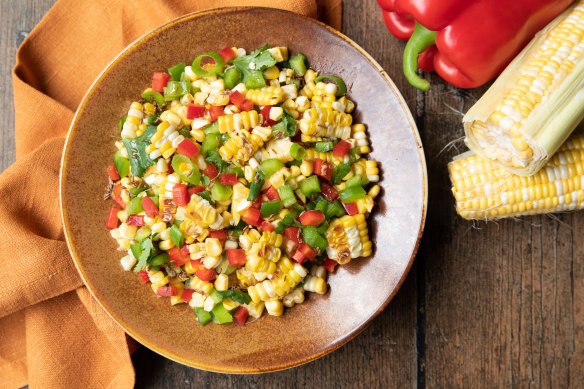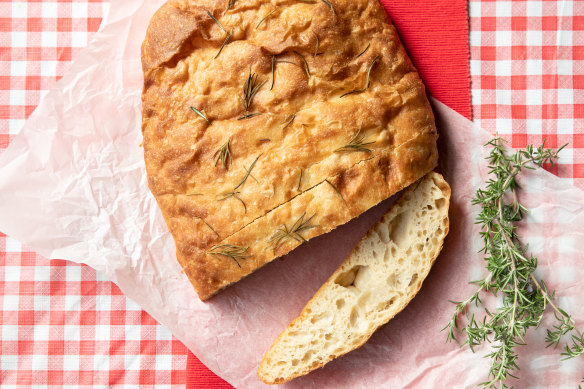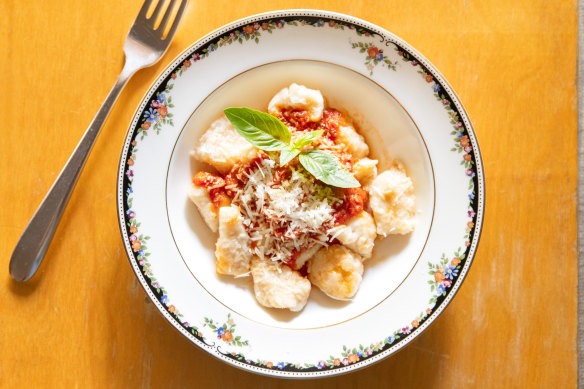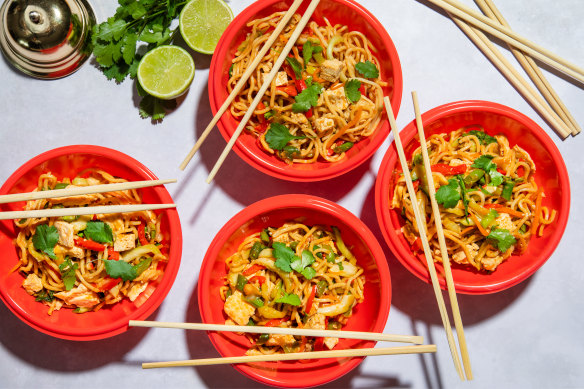Four Stephanie Alexander veg recipes that kids actually love to eat (and cook)
These simple dishes have been trialled, eaten and approved by kids, making them perfect for less experienced cooks.
For two decades, the Stephanie Alexander Kitchen Garden Program has honed its recipes on the most discerning taste testers of all – the kids involved in the hands-on growing, harvesting and cooking education scheme.
The program, a passion project driven by food writer, educator and former restaurateur Stephanie Alexander, began with a pilot scheme in one inner-city Melbourne school and has since expanded to more than 1000 schools nationwide.
This year marks the 20th anniversary of the Stephanie Alexander Kitchen Garden Foundation, which grew out of those first green shoots.
Of all the recipes tested on students and youngsters in early childhood programs, these are the most popular.

Corn salsa
Children will enjoy getting hands-on with this easy and versatile Mexican side dish. For a quicker, crunchier version, skip the frying of the capsicum. You can use the salsa alongside toasted tortilla wedges or as a topping in burritos.
Ingredients
- 1 green capsicum
- 1 red capsicum
- 4 corn cobs
- 2 spring onions
- 1 tsp cumin seeds
- ½ tsp coriander powder
- 1 tbsp extra virgin olive oil
- salt and pepper
- handful of fresh coriander leaves
Method
- Deseed, finely slice, then dice the capsicums. Carefully slice the corn kernels from the cob. Slice the spring onions finely. Set each ingredient aside in separate bowls.
- Dry-fry the cumin and coriander powder in a large frying pan for 1 minute, then add the oil.
- Add the capsicum and fry for 5 minutes.
- Add and stir through the corn kernels, cover with a lid and cook for 5-7 minutes. Take off the heat and leave, covered, to steam for a few minutes.
- Stir in the spring onions. Taste for seasoning, adding salt and pepper if necessary.
- Tear up the coriander leaves and sprinkle over the salsa before serving.
Serves 4

Basic focaccia
A focaccia is a flat Italian loaf that you can top with seasonal herbs, fruit and vegetables. This recipe provides a tactile experience. It’s a sticky dough, but please resist the urge to add more flour during the kneading process, as it will come together with time and persistence. The high water content is important to achieve the focaccia’s spongy centre and crisp crust.
Ingredients
- 7g dried yeast
- 400g lukewarm water
- 1 tsp honey
- 600g bread flour
- 1 tsp salt, plus a pinch
- 4 tbsp olive oil, plus extra for oiling the bowl
- rosemary sprigs
Method
- Activate the dry yeast by placing it with the water and honey in the medium bowl and mixing it with a fork. Leave the yeast mixture in a warm place for 5-10 minutes. It will start to look frothy as the yeast ferments the honey into carbon dioxide.
- Place the flour and salt into a large bowl. Create a well in the centre. Add the yeast mixture into the well. Use the tips of your fingers to incorporate the yeast mixture into the flour, mixing just until the mixture clings together into a shaggy dough.
- Drizzle 1 tablespoon of olive oil over the dough. Cover the bowl with a clean tea towel and rest for 5 minutes or overnight in the fridge.
- Form the shaggy dough into a ball and tip it onto a clean, dry workbench. Start kneading with your hands flat to minimise the dough sticking to them. Knead the dough for at least 5 minutes until it can be shaped into a ball. It is likely to still be sticky to the touch. By keeping the dough moving, the gluten in the flour will absorb the water and a tacky ball should form. If it becomes uncomfortable, clean your hands, lightly cover them with a little oil and return to kneading the dough without adding more flour.
- Use a pastry brush to lightly oil a large bowl, then place the dough in the bowl. Drizzle 1 tablespoon of oil over the dough. Cover the bowl with a tea towel and leave for 15 minutes in a warm spot.
- Preheat the oven to 200C fan-forced (220C conventional). Using your fingers, pick the dough up from the far side of the bowl and pull it towards you, folding it into the centre of the bowl. Turn the bowl 90 degrees and repeat three more times.
- Turn the dough upside down. Cover the bowl with a tea towel and leave for 10 minutes in a warm spot.
- Line a baking tray with baking paper. Tip the dough onto the baking tray. Spread the dough out into a rectangular shape about 2cm thick.
- Drizzle 2 tablespoons of olive oil over the dough and make indentations all over the surface using your fingertips. Leave for 10 minutes in a warm spot.
- Sprinkle with a pinch of salt and scatter with sprigs of rosemary. Bake it in the oven for 20 minutes or until golden brown. Remove the baking tray from the oven and allow the focaccia to cool before serving.
Makes 1 large focaccia

Basic gnocchi
Rolling and cutting fresh, soft gnocchi dough is a wonderful sensory experience. This recipe shows how easy it is. To save time, cook the potatoes in advance.
Ingredients
- 1kg large Desiree potatoes (about 5 or 6)
- 350g plain flour, plus extra for kneading
- 1 egg
- 1 tbsp salt
- tomato and garlic sauce (see recipe) to serve
- grated parmigiano reggiano to serve
Method
- Place the potatoes in their skins in a stockpot, cover with water and boil until tender. Drain the potatoes and allow them to cool slightly in the colander before peeling. (Note: If using a potato ricer, you will not need to peel the potatoes.)
- Put the potatoes into the large bowl and mash them with a masher until smooth, or pass them through a ricer or a Mouli food mill. Do not over-mash or the potato will become sticky and your gnocchi will be heavy.
- Rinse the stockpot, refill with water and bring it to a boil.
- Pour the flour onto a clean workbench, reserving 2 tablespoons to use later, if required. Put the mashed potatoes on top of the pile of flour, add the egg and quickly knead the mixture into a soft dough. If necessary, sprinkle on a little extra flour to stop the dough sticking to the workbench.
- Divide the dough into four equal pieces, then roll each into a 2cm-wide log. Cut the logs with a butter knife at 0.5cm intervals to create gnocchi, then lightly press each gnocco with a fork to create ridges (don’t squash them flat!).
- Dust the gnocchi with a little more flour to stop them from sticking. Dust a baking tray with flour and spread the gnocchi onto the tray.
- To cook the gnocchi, add a tablespoon of salt to the boiling water, then carefully drop the gnocchi, piece by piece, into the pot, making sure they do not stick together. Boil them in two batches if necessary to avoid crowding the pot.
- While the gnocchi are cooking, heat the tomato and garlic sauce in a medium saucepan over medium heat.
- The gnocchi are cooked when they rise to the surface. Spoon them out with the slotted spoon and place directly into the sauce, or into a serving dish. Scatter on grated parmigiano reggiano before serving.
Serves 4
Tomato and garlic sauce
This sauce can be used on pasta, as a pizza topping, or as a base for casseroles and stews. Once you understand the fundamental flavours, you can adapt the recipe to your preference – adding onion, if you like, or chilli, as well as basil, oregano or marjoram.
Ingredients
- 2 tbsp extra virgin olive oil
- 3 or 4 garlic cloves, peeled and finely chopped
- salt, to taste
- 1 kg tomatoes (or 3 tins of whole tomatoes), roughly chopped
- ½ tsp sugar
- freshly ground black pepper, to taste
Method
- Prepare the ingredients based on the instructions in the ingredients list.
- Heat the oil in the frying pan and add the garlic and a pinch of salt. Cook for 30 seconds.
- Add the tomatoes, sugar and pepper.
- Cook for at least 10 minutes, and up to 30 minutes. The cooking time depends on the time you have available and the type of flavour you want the sauce to have: less cooking results in a fresher flavour, while longer cooking results in a deeper, more intense flavour.
Serves 6

Mie goreng
This classic Indonesian dish uses traditional flavours of garlic, chilli and lime. You can substitute chicken for the tofu, adjust the ingredients to suit the season, and experiment with different combinations of Asian greens and herbs.
Ingredients
- 2 garlic cloves, peeled
- 1 shallot, roughly chopped
- ½ red chilli, deseeded and chopped
- ¼ tsp salt
- 2 eggs
- 150g dry noodles
- 1 tbsp sunflower oil
- ½ tsp sesame oil
- 100g tofu or chicken, chopped into bite-sized pieces
- 1 small carrot, peeled and julienned
- ½ capsicum, sliced
- 8 green beans, roughly chopped
- 2 spring onions, sliced diagonally
- 65ml kecap manis (thick sweet soy sauce)
- 65ml light soy sauce
- ½ tbsp brown sugar
- 150g bok choy, roughly chopped
- 1 cup bean sprouts
- ¼ bunch coriander, leaves picked
- 1 lime, sliced into wedges
Method
- Pound the garlic, shallots and chilli to create a paste using a mortar and pestle, then add ¼ teaspoon of salt.
- Whisk the eggs in a bowl. Heat a wok over high heat, add the sunflower oil. When it is just shimmering, pour the egg mix into the wok. Cook until the egg is cooked right through and looks like an omelette.
- Transfer the omelette to a chopping board. Roll it up, slice it into strips and set aside.
- To cook the noodles, bring a medium saucepan of water to a boil. Boil the noodles for 2-3 minutes, drain and rinse with cold water. Toss them through the sesame oil to stop the noodles from sticking together.
- Heat the sesame oil in the wok and when hot, add the garlic, shallot and chilli paste. Cook for 30 seconds.
- Add the tofu or chicken and fry for 2 minutes. Add the carrot, capsicum, beans and spring onions, and cook for 2 minutes. Increase the temperature to high and add the cooked noodles.
- Add the kecap manis, soy sauce and brown sugar, then mix well. Add some of the sliced omelette (reserve the rest for a garnish) and stir continuously for 30 seconds.
- Now add the bok choy and cook for about 2 minutes, stirring continuously. Taste, and adjust seasoning if necessary. Top with bean sprouts, fresh herbs and lime wedges to serve.
Serves 4
Appears in these collections
The best recipes from Australia's leading chefs straight to your inbox.
Sign up